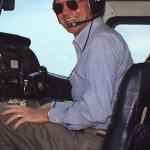
As we have occasionally in the past, we’ve opened up the WAC AirViews Blog to a guest blogger. Charles Lloyd, a loyal WAC member and contributor to both Cessna Pilot and Piper Pilot magazines, offers his take on refurbishing and updating owner-flown aircraft, a hot topic in the industry with the advent of so many high capability but lightweight and compact navigational and communication systems that can be easily retrofitted into older aircraft. In his blog entry below, Charles discusses how to acquire and modify a Cessna 172 or Cessna 182 to NextGen standards for $100,000 or $130,000.
How can you get a NextGen equipped 172 or 182 for that price. Today, a new Cessna 172 is $350,000 or 182 is $500,000. I did not say it is a new one. Thirteen years ago I bought a 1966 Cessna 182 for $50,000 and gradually over the next seven years added $50,000 in avionics upgrades to create a nice IFR flying machine. This Garmin based package includes dual Garmin GPS WAAS navigators, NEXRAD satellite weather, Stormscope, electric attitude indicator with 1-hour battery backup, single axis autopilot and no glass.
You can still use this approach today and meet the budget in the title. The assumptions are a late seventies aircraft with a King Silver Crown radio stack with a mid-time engine. Paint and interior are OK and you can live with what you see. The plan is to create a IFR package that you plan to fly for 10 years. This is not a fix up to sell and get rich scheme. NextGen is slowly coming alive and ADS-B is just around the corner in 2020. Garmin 430 and 530 GPS navigator are great but the manufacturer is committed to supporting these units 2021 period. Be careful on planning your approach around a 430/530 foundation.
If I did it today my plan would be slightly different. One GPS navigator either a GTN650 or 750 will be adequate. For the second NavCom, use the King KW155 with glide slope capability that was your number 1 unit. If you don’t have a KW155 then get your shop to find a good used unit. Narco Mark 12s or King 170B will not provide the reliability you will need for IFR reliability.
Garmin’s GDL 88 is a good price performer for ADS-B in and out. While the NEXR weather is not a crisp and the Sirrus MX weather, the price is right at no charge and you will receive traffic advisories from the UAT ground stations with your current Mode C transponder.
Finally, glass is here and proving is worth. Glass is more reliable with no moving mechanical parts. Aspen offer a modular one step at a time approach to the glass cockpit. Starting with the Evolution 1000 Pro PFD, you can add one or two additional MFD panels. Garmin’s 500 glass six pack is a all or nothing approach and is a bigger investment all at once versus the Aspen one step at a time method.
The S-TEC Cobham System 30 is a rate based two axis autopilot that is self contained in the turn coordinator, and my thirteen years experience with a slightly more expensive Model 40 is excellent. It works fine last a long time.
How do we mix and match the above overview. For the Skyhawk here are my recommendations. Start with a Garmin GNS 650 and move the King KW155 to the number 2 NavCom position. A PMA xx will slip into the King xx audio panel slot. Single pilot IFR in a GA aircraft is some of the highest workload flying there is. It is time for the S-Tec Model 30 autopilot installation. Add a Garmin GDL 88 to work with you King KT76A Mode C transponder for traffic and a weather data link. The final addition is an Aspen Evolution 1000 Pro PFD that adds solid state AHRS reliability for your glass ADI and HSI. How much will this cost? Working with Bevan Rebel’s Kent McIntyre the cost today for this package is $47,500. Add this to your $45,000 late 70’s Skyhawk and you have an aircraft equipped to fly you well into the future. Finally remember you don’t have to install this package all at one time. Get with a good shop and plan you approach to IFR flying to get a lot of bang for your buck.
For the Skylane, start with the big screen GTN 750 and move the King KW155 with glide slope to the number 2 position. Add the Midcontinent Lifesaver Electric ADI with one-hour battery backup. Everything else is the same at the Skyhawk.

